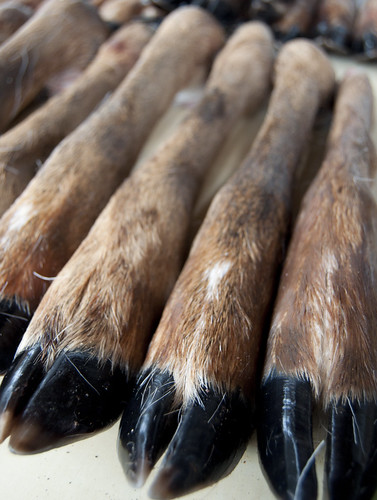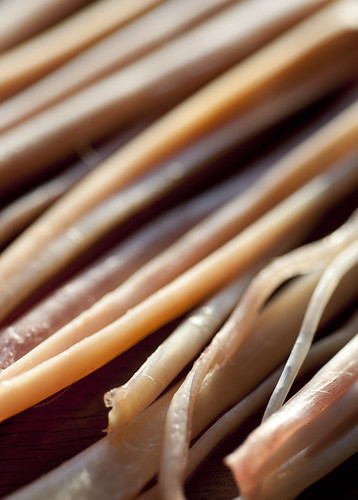But what to do with the two dozen deer legs? It was a bitterly cold day, and our covered porch was hardly any warmer. I laid out the legs I'd received, and counted twenty-six in all, as well as four stubby, white goat legs that had also made it into the mix.
It was pretty neat to see the variation in size, color, and shape amongst the legs. Rarely do we get the opportunity to see so many deer feet at once, but when they are all lined up, the differences and genetic variations become quite obvious.
Because it was so cold outside, the porch became a suitable walk-in freezer for the legs. I skinned several of them immediately, and over the past week, I've whittled down the remaining number to fifteen. On a particularly warm day, I somehow found room in the chest freezer for the rest of the unskinned legs.
So, why deer legs? If there ever was a "useless" part of a creature, it would be the leg. This is especially true for deer, whose legs literally lack meat. They aren't good for eating, so all too often, they are thrown away (or turned into hideous lamps and gun racks). But uselessness is a subjective term, and whereas one thing is useless to one person, that same item can have a variety of uses for another. Deer legs are a wonderful example of this: though they lack meat, they have tendons, bones, hooves, and of course, the skin and fur. No, these materials aren't good for eating, but they have many, many other uses -- one just has to be patient, willing to try new skills, and be prepared for failure (or success).
Skinning a deer leg is an easy process, and since I am in possession of so many, I've got the ability to try different styles. Sometimes, I keep the dewclaws attached; other times, I cut around them. I skinned one leg in such a way that I kept all four hooves attached -- we'll see what I end up doing with that particular skin.
Once the leg has been skinned, it's time to cut out the tendons. Beneath all that fur, a deer leg is almost nothing but bones and tendons; it's an elegant structure, but one does have to wonder how they don't get cold! When fresh, the tendons are a pearly white-pink color. As they dry, they turn a translucent pink-yellow.
The uses for the skin and fur are rather obvious: buckskin, pouches, strips of fur for lining and insulating clothes... the list goes on. But what are tendons used for? Once cleaned and dried, they are pounded until they separate into strands. These strands of sinew can then be turned into cordage (string), which can prove to be useful in a pinch.
The bones and hooves have many uses as well. I'm using this guide (PDF) as I render these twenty-six deer legs into things that will be useful to me. I think it's very important to have some knowledge of traditional skills; these ways were used by our ancestors, and they're still used today. These deer legs could be rotting in a landfill -- instead, they will help me better understand traditional outdoor ways -- skills that have largely been forgotten by my generation.






cool post, Jorie. Your great grandpa Clarence Dupre would be quite proud of you. :)
ReplyDeleteMethinks it's time for a new blog - The Useful Creatures.
ReplyDeleteVery interesting post!! I was about to disagree with you about the deer leg lamps and gun-racks, and I still do, because those products are neat, but what you have succeeded in showing me, is the value of the parts we throw away, such as the bone and sinew!! Thanks!
ReplyDeleteYou should render the oils from the deer leg bones. It makes a wonderful deer version "Neatsfoot oil" for oiling tanned leather.
ReplyDeleteThat is if you don't scoff all the nutritious soup first :)
Crack open those leg bones and simmer for stock! The marrow is delicious and nutritious!
ReplyDeletedo you still have any of the legs left? I'm lookin' for a set or a few sets
ReplyDelete